Smoke control is a complex process involving smoke extraction and fresh air supply by the supply and extract ventilation system of buildings in order to ensure safe evacuation of people in case of a fire in any of the spaces.
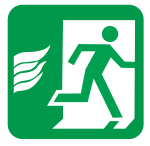 |
The smoke control system of a building or structure must ensure protection of people along the evacuation paths from the fire hazards during the time required for the personnel evacuation procedure or the entire period of fire development and control by means of extracting the combustion and thermal decomposition products and/or preventing their spreading. A smoke control system is an integral element of a utility system design including all kinds of high-rise structures, shopping and office centres, hospital facilities, production and storage spaces etc. as well as underground structures. |
 |
According to conclusive evidence the majority of mortalities in a fire are caused by poisoning from carbon monoxide and other combustion products. Carbon monoxide is one of the most toxic smoke components. It is carbon monoxide poisoning that accounts for 80% the fire accident causes. Fires in closed spaces where oxygen supply is limited are especially prone to intensive carbon monoxide generation. Carbon monoxide poisoning occurs when its concentration in the inspiratory air exceeds 0.08%. Concentration growth up to 0.32 % results in paralysis and loss of consciousness (with imminent death in about 30 minutes). Concentrations in excess of 1.2% lead to loss of consciousness after 2-3 aspirations whereas another 2-3 minutes are fatal. Smoke spreads much faster than fire, therefore causing loss of consciousness and cardiac arrest before the victim reaches the safety outdoors. Furthermore, smoke contamination impacts spatial orientation forcing the victim to negotiate obstacles by touch and, quite often, to divergefrom the escape paths. |
Fire in a Building Without a Smoke Control System

Fire in a Building Equipped with a Smoke Control System

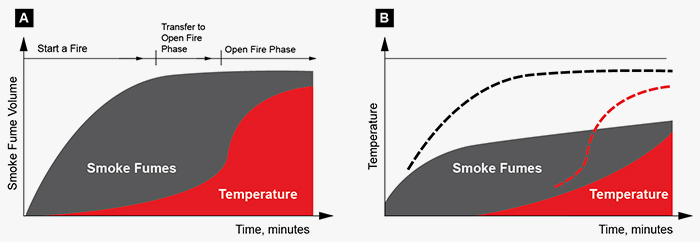
 |
Chart "A" clearly shows that at the fire origin where no fire control systems are present the smoke fume volume rapidly becomes critical.
However, chart "B" shows that a fire control extraction system helps to significantly reduce the content of smoke in the gas environment which remains below the safety threshold during the entire duration of fire.
|
 |
Smoke control system functions:
-
Prevention of smoke spreading from the ignition source.
-
Prevention of smoke transfer to the evacuation paths (maintaining acceptable conditions for the people being evacuated from thebuilding).
-
Maintaining a microclimate beyond the ignition source area to enable normal operation of fire-fighting teams.
-
Protecting the life of people in the building.
-
Protecting the property against damage.
|
The smoke control system elements are integrated at the initial phase of the building (residential complex, office block, warehouse facility etc.) construction. These communications must be contained in the design engineering documents specific to the life-support system. All the works specific to the design and installation of smoke control systems are strictly covered by the applicable construction standards and regulations.
Smoke control plays a paramount role in making a building safe and ensuring compliance with any and all fire safety standards and regulations. Purpose-built smoke exhaust duct lines provide additional safety and enable easy evacuation of people using corridors and stairs which are completely free of hazardous fumes.
Smoke control is a complex process affected by numerous conditions and factors, and, therefore, the design of such communication systems requires an expert qualification. Smoke control systems must only be designed by professionals since any disregard of the commonly accepted state regulations may lead to human casualties.
A smoke control systems consist of:
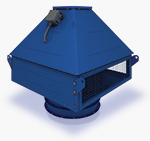 |
Smoke exhaust fans which are used in emergency exhaust ventilation systems for forced extraction of smoke and heated gases and simultaneous transfer of heat generated by the fire away and beyond the limits of the serviced spaces where the ignition occurs. Such units are used in production, public, residential, administrative and other spaces. Such fans are capable of handling smoke and air mixtures with temperatures up to 600 °С. |
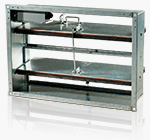 |
Smoke dampers installed on the protected premises accept smoke fumes and channel them into smoke shafts. Such devices are equipped with electromagnetic or electric actuators. The dampers are rated according to the fire-resistance limit which can vary up to 180 minutes at the smoke temperature of 600 °С. |
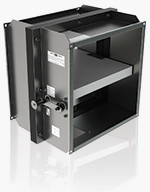 |
Fire-resisting dampers are installed in exhaust ventilation and general ventilation systems to prevent the spread of fire hazards (fire and smoke fumes). Such units are equipped with an electric actuator or a thermal lock. |
 |
Ventilation air ducts and shafts are intended for transferring smoke fumes from the protected premises away from the building. Air ducts are made of non-combustible materials. |
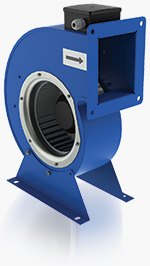 |
Pressurization fans are intended for creating a positive pressure differential in lift shafts, at landings and in air-lock corridors to prevent their contamination by smoke. |